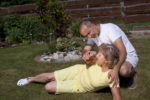The body is very effective at Thermoregulation – maintaining the correct internal temperature in extreme conditions of heat and cold. As humans, we can go skiing in freezing cold conditions or lay on a hot sunny beach. Controlling the Temperature of the Body We control our temperature by various means. Some are conscious decisions we […]
Understanding Heat Stroke
Heat stroke, or sun-stroke, is a severe heat illness characterised by a core body temperature exceeding 40°C (104°F) and central nervous system dysfunction. It can result from high external temperatures, physical exertion, or both. Immediate medical attention is crucial to prevent complications such as seizures, rhabdomyolysis, or kidney failure.
Recognising Heat Stroke Symptoms
Common signs and symptoms include:
- High body temperature (above 40°C or 104°F)
- Red, hot, and dry skin (absence of sweating)
- Headache
- Dizziness and confusion
- Nausea or vomiting
- Rapid, strong pulse
- Loss of consciousness
It’s important to note that symptoms can vary between individuals, and some may experience atypical signs. For a detailed overview of heat stroke symptoms, refer to the Heat Emergencies – Heat Stroke page.
Immediate First Aid Response
If you suspect someone is experiencing heat stroke:
- Call Emergency Services: Dial 999 or 112 immediately to request an ambulance.
- Move to a Cooler Environment: Relocate the person to a shaded or air-conditioned area.
- Remove Excess Clothing: Take off any unnecessary clothing to facilitate cooling.
- Cool the Person: Apply cool water to the skin, use fans, or place ice packs wrapped in cloth on the neck, armpits, and groin.
- Monitor Vital Signs: Keep a close watch on their breathing and consciousness levels.
- Prepare for CPR: If the person becomes unresponsive and is not breathing normally, commence cardiopulmonary resuscitation (CPR) immediately. For guidance on performing CPR, visit the Adult CPR page.
Preventing Heat Stroke
To reduce the risk of heat stroke:
- Stay Hydrated: Drink plenty of fluids, especially during hot weather or physical activity.
- Avoid Excessive Heat Exposure: Limit time spent in direct sunlight, particularly during peak hours.
- Wear Appropriate Clothing: Choose lightweight, loose-fitting, and light-coloured garments.
- Take Frequent Breaks: Rest in shaded or cool areas during prolonged outdoor activities.
- Be Cautious with Medications: Some medications can increase the risk of heat-related illnesses; consult with a healthcare provider.
Further Resources
Expand your knowledge on heat-related illnesses and emergency response:
- Cold Emergencies – Hypothermia
- The Recovery Position: How and When to Use It
- Calling the Emergency Medical Services
- Understanding the Respiratory System
For comprehensive first aid training, consider enrolling in our First Aid at Work Annual Refresher (VTQ) course.

